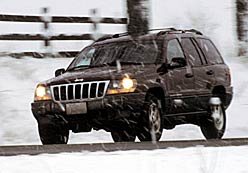 As a part of their sponsorship for the 2007 Winter X Games, Chrysler Group’s Jeep brand division has teamed up with Dr. John R. Tongue of the American Academy of Orthopedic Surgeons and professional snowboarder Stacy Thomas for the Jeep Safe Way to Play campaign. The campaign aims to provide winter sports enthusiasts and other peeps some safety winter sports safety tips. Here are some of them.
As a part of their sponsorship for the 2007 Winter X Games, Chrysler Group’s Jeep brand division has teamed up with Dr. John R. Tongue of the American Academy of Orthopedic Surgeons and professional snowboarder Stacy Thomas for the Jeep Safe Way to Play campaign. The campaign aims to provide winter sports enthusiasts and other peeps some safety winter sports safety tips. Here are some of them. General Winter Sport Safety Tips
* Protect your noggin: Children 12 years and younger should wear helmets when sledding, skiing or snowboarding and everyone should wear a helmet when snowmobiling to prevent head injuries. The most serious sledding injuries and most common skiing injuries result from collisions with fixed objects, such as rocks or trees. Wearing a helmet can help reduce the seriousness of these injuries.
* Use the buddy system: Never participate in winter sports alone. Always select a partner and be sure to stay together when playing outdoors.
* Dress for success: It is important to choose proper clothing when heading outside. Wear layers of light, loose, and water and wind-resistant clothing. The water-resistant outer layers will help keep participants dry when they fall and the layers will accommodate the body's changing temperature. Bright colored clothing is the best because it can be seen at a great distance.
Sledding Tips
* Ride in style: The safest way to ride a sled is to sit in a forward-facing, feet first position. To decrease the chance of injury, avoid sledding downhill head first.
* Think with your head when choosing a sled: Avoid sleds that are made out of thin plastic sheets. They can be pierced and steered by sharp objects that may be buried in the sledding path. The safest sleds are equipped with runners and a steering mechanism.
* Supervise your children: The majority of sledding injuries occur in the areas at the end of a sledding path. Adult supervision is needed to ensure that children sledding down the hill do not collide with other children at the end of the path.
Skiing/Snowboarding Tips
* Fall like a pro: Learning how to fall is just as important as learning how to ski or snowboard. Whenever possible, skiers and snowboarders should fall forward or sideways instead of backwards to decrease the chance of a serious knee injury.
* Watch the weather: Skiers and snowboarders should keep a look out for icy patches and be prepared to make adjustments for ice, deep powder snow and wet snow while on the slope. As snow gets packed down and turns firm, skiing and snowboarding becomes more difficult and runs down the hill become quicker.
* Don't start cold: At the start of each new day, skiers and snowboarders should take a couple of slow runs to warm up their bodies and become familiar with the slopes.
Snowmobiling Tips
* Drive on the right side: When traveling on snowmobile trails always stay to the right - just like driving on the road - and always slow down at the top of a hill, cliff or snow bank to help prevent collisions with oncoming snowmobiles or unforeseen objects.
* Use designated hand signals: It is often difficult to hear over the noise of snowmobiles, so keep the lines of communication open with hand signals. Before heading out with a group, identify hand signals that can be used to tell others when to speed up, slow down, stop, turnaround, etc.
* Leave a note: Before departing on a snowmobile trip, always leave a note describing where you're going, who you're with, when you plan to return, and what equipment you have with you. Leave the note with a friend, at the front desk at a hotel or with someone who will notice if you do not return in a timely manner.
Driving Tips
* Drive slowly: When driving in the snow, do everything slowly. Even when driving vehicles that are equipped with the newest safety features, like the traction control system and electronic stability program that come standard on all Jeep vehicles, drivers should accelerate, turn and break slowly and gently.
* Watch for ice: Be aware of potential icy areas such as shady spots and bridges. Even if it's blue skies and sunny, it's still icy on bridges and in the shade throughout the winter months.
* First Aid Kit: You should keep first aid items (bandages, aspirin, and wraps) in your vehicle in case someone gets injured on their way to or from winter sporting activities.
Driving on the winter season might damage your wheels & rims so you better follow the tips above.